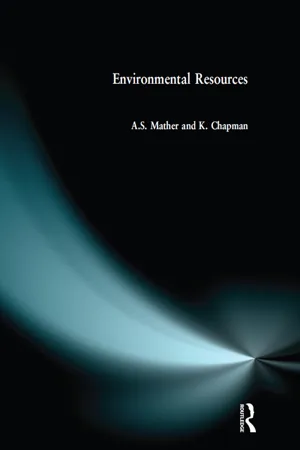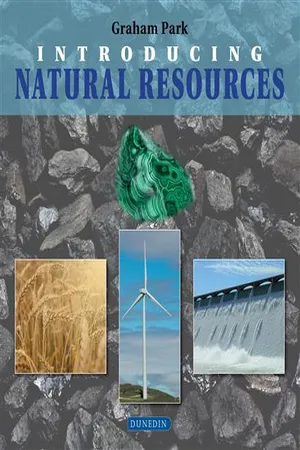Geography
Non Renewable Energy Sources
Non-renewable energy sources are natural resources that cannot be replenished within a short period of time. These include fossil fuels like coal, oil, and natural gas, as well as nuclear energy. Non-renewable energy sources are finite and contribute to environmental pollution and climate change. As a result, there is a growing emphasis on transitioning to renewable energy alternatives.
Written by Perlego with AI-assistance
Related key terms
5 Key excerpts on "Non Renewable Energy Sources"
- eBook - ePub
- A.S. Mather, K. Chapman(Authors)
- 2018(Publication Date)
- Routledge(Publisher)
Supplies of 235 U were initially thought to be limited. This perception stimulated attempts to develop a ‘closed’ cycle in which spent fuel from nuclear power stations is reprocessed to create new fuel rods for return to the original power station. This practice was viewed as a means of delaying considerably the rate of depletion of uranium resources. The prospect of infinitely renewable nuclear energy was subsequently raised by further technological developments epitomized in the concept of ‘fast-breeder’ reactors based on nuclear fusion. This technology remains a theoretical possibility rather than a practical proposition, however, and prevailing applications of nuclear power are essentially non-renewable (see pp. 146 – 8). Geothermal energy Similar ambiguities arise in classifying geothermal energy as a renewable or non-renewable source. As currently used it is non-renewable in the sense that it depends upon using heat contained in water and steam trapped in pockets near the Earth’s surface. These pockets are analogous to oil reservoirs and are finite. Although geothermal energy is used to generate electricity and also to provide direct space-heating in several countries including Italy, New Zealand and Iceland, its contribution to global energy production is negligible. Theoretically it could be regarded as a renewable energy source if a commercially acceptable means of exploiting the rise in temperature evident in boreholes penetrating the Earth’s crust could be found (i.e. terrestrial heat flow in Fig. 7.1). ‘Fossil’ fuels The fossil fuels of coal, oil (including oil shales and tar sands) and natural gas represent forms of chemical energy, ultimately created by solar radiation (Fig. 7.2), and locked by geological processes into energy stores. The energy contained in these stores is released by combustion. They are undeniably non-renewable on a human time scale, although it is difficult to judge the size of their respective resource bases (see p. 143 et seq.) - eBook - ePub
- (Author)
- 2015(Publication Date)
- Dunedin Academic Press(Publisher)
The distinction between renewable and non-renewable energy is at the heart of the current debate about measures to combat climate change. The distinction is not always clear-cut, since some ostensibly renewable materials (e.g. timber) could be depleted if not managed carefully, and windgeneration structures use a significant amount of non-renewable energy in their manufacture. However, other examples are more obvious; fossil fuels are clearly non-renewable, as are most forms of chemical energy. Nuclear energy is an interesting example of a supposedly ‘green’ energy source (it does not release greenhouse gases) but since it is, at present, reliant on uranium, an exhaustible fuel, it must be considered to be non-renewable.The principal sources of non-renewable terrestrial energy are: fossil fuels (coal, oil and natural gas) and nuclear processes. Renewable resources are discussed in the following chapter.Fossil fuels
Fossil fuels are currently the largest suppliers of energy, although their role in global warming has meant that many countries are attempting to reduce their use in favour of more environmentally friendly options. The three main types of fossil fuel – coal, oil and natural gas – are all derived from decayed organic material that has been buried, compressed, subjected to various tectonic processes such as folding and faulting, and now forms part of the geological record. They actually form a spectrum of material, in the sense that oil and gas are merely the more mobile of the products of organic decay, and typically migrate upwards into different rock strata where they may become concentrated and exploited.Coal
Coal has been exploited as a fuel since at least the Bronze Age in Britain, where there is evidence of its use for funeral pyres, and in the first millennium BCE in China, for smelting copper. The Romans exploited coal in England and Wales, but it was only widely available as a fuel from about the thirteenth century, at first from easily accessible surface deposits, and later mined from shallow shafts. Deep coal mining became common during the Industrial Revolution, and by the 1830s in Britain, coal had replaced watermills as a source of power generation. Deep coal mining in Britain has been replaced by nearsurface quarrying (‘opencast mining - eBook - ePub
Sustainability
An Environmental Science Perspective
- John C. Ayers(Author)
- 2017(Publication Date)
- CRC Press(Publisher)
9 Nonrenewable Energy SourcesEnergy may be our most important resource, and energy availability will likely be the ultimate limit on population and economic growth. Abundant energy makes it easy to be sustainable because it can be used to produce essential resources such as food and potable water where they are scarce. However, many areas of the world are experiencing energy shortages. Furthermore, 88% of the world’s energy comes from burning fossil fuels, which adds the greenhouse gas carbon dioxide to the atmosphere, intensifying global climate change (Princen, Manno, and Martin 2013). The fossil fuel era began when fossil fuels surpassed wood as the dominant energy source, but it is not permanent. To become sustainable, our society must transition from nonrenewable fossil fuels to renewable energy sources. Having covered oil in Chapter 6 , we will review sustainability issues associated with the remaining nonrenewable energy sources in this chapter before reviewing renewable energy sources in Chapter 10 . In Chapter 11 we will compare the costs of these energy sources and review policy options.9.1 IntroductionEnergy comes in many forms, including chemical, mechanical, electrical, heat, and light. We use energy to perform work, usually by converting it from one form that stores it to another. For example, fossil fuels and electrochemical batteries store chemical energy. To propel conventional autos that have internal combustion engines we burn gasoline or diesel to convert the stored chemical energy to mechanical energy. Electric cars convert chemical energy stored in electrochemical batteries to mechanical energy, with the added advantage that they don’t emit carbon dioxide.Some forms of energy are more useful than others. Heat is considered low quality energy because it is dispersed. Electricity is a high quality form of energy because we can transport it through conductive wires, store it in batteries, and use it to make other forms of energy. We also can use it for electronic communication, which makes it indispensable to modern society. As a result, we typically convert other forms of energy to electricity. For example, mechanical energy in flowing water or steam is converted to electrical energy using a turbine. According to the second law of thermodynamics, each time we convert other forms of energy to electricity we lose some energy, but the increased utility of electricity balances this loss. - eBook - ePub
- Kornelis Blok, Evert Nieuwlaar(Authors)
- 2016(Publication Date)
- Routledge(Publisher)
5 Energy extraction and conversion This chapter will provide an overview of the supply side of the energy system. The historic development of primary energy supply by source is given in Figure 5.1. Before the Industrial Revolution, bio-energy was the main energy source. In the course of the twentieth century, fossil fuels became dominant, first coal, then oil and natural gas. There are small roles for nuclear energy and hydropower. Bio-energy supply remained quite stable, but displayed growth in recent years. New renewable energy sources, like solar energy and wind energy still have a very small share, but are growing rapidly. In this chapter, first non-renewable energy sources (5.1 and 5.2) and renewable energy sources (5.3) will be examined. The following sections turn to energy conversion, looking at the electricity sector: power plants (5.4) and combined generation of heat and power (5.5). Next, we discuss electricity transmission and distribution systems (5.6). Finally, oil refineries will be considered in Section 5.7. Figure 5.1 Global energy use by primary energy source from 1850 to 2014. Primary energy use is shown according to the IEA convention. This suggests for hydropower and new renewables (solar, wind, geothermal, etc.) a smaller contribution than they actually deliver (see Section 2.10) (source: adapted and updated from Grübler et al. 2014) 5.1 Non-renewable energy sources The non-renewable energy sources currently in use are fossil fuels and uranium. The three main fossil fuels are coal, oil and natural gas. Coal is a sedimentary rock that is formed by chemical modification of large amounts of plant debris, such as leaves, bark and wood. Plant structures can still be identified when coal is examined under a magnifying glass. Other constituents of coal can include silicate, carbonate and sulphide minerals - eBook - ePub
- John R Fanchi(Author)
- 2013(Publication Date)
- WSPC(Publisher)
The choices we make today will affect generations to come. What kind of future do we want to prepare for them? What kind of future is possible? We can make the best decisions by being aware of our options and the consequences of our choices. In this book, we consider the location, quantity and accessibility of energy sources. We discuss ways to distribute available energy, and examine how our choices will affect the economy, society, and the environment. Our understanding of each of these issues will help us on our journey to energy independence. We begin by defining energy and reviewing our history of energy consumption.1.1 WHAT IS ENERGY ?Energy is the ability to do work. It can be classified as stored (potential) energy, and working (kinetic) energy. Potential energy is the ability to produce motion, and kinetic energy is the energy of motion. Forms of energy include energy of motion (kinetic energy), heat (thermal energy), light (radiant energy), photosynthesis (biological energy), stored energy in a battery (chemical energy), stored energy in a capacitor (electrical energy), stored energy in a nucleus (nuclear energy), and stored energy in a gravitational field (gravitational energy).Sources of energy with some common examples include biomass (firewood), fossil fuels (coal, oil, natural gas), flowing water (hydroelectric dams), nuclear materials (uranium), sunlight, and geothermal heat (geysers). Energy sources may be classified as renewable or nonrenewable. Nonrenewable energy is energy that is obtained from sources at a rate that exceeds the rate at which the sources are replenished. Examples of nonrenewable energy sources include fossil fuels and nuclear fission material such as uranium. Renewable energy is energy that is obtained from sources at a rate that is less than or equal to the rate at which the sources are replenished. Examples of renewable energy include solar energy and wind energy.Renewable and nonrenewable energy sources are considered primary energy sources because they provide energy directly from raw fuels. A fuel is a material which contains one form of energy that can be transformed into another form of energy. Primary energy is energy that has not been obtained by anthropogenic conversion or transformation. The term “anthropogenic”refers to human activity or human influence. Primary energy is often converted to secondary energy for more convenient use in human systems. Hydrogen and electricity are considered secondary sources of energy, or “carriers”of energy. Secondary energy sources are produced from primary sources of energy and can be used to store and deliver energy in a useful form.
Learn about this page
Index pages curate the most relevant extracts from our library of academic textbooks. They’ve been created using an in-house natural language model (NLM), each adding context and meaning to key research topics.




